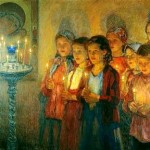by Metropolitan Hierotheos of Nafpaktos
 But before I proceed to elaborate the subject of the “origin and revelation of the Church”, I would like us to take a look at the etymology of the word “Ekklesia“, because it will help us to understand better what is going to be said further on.
But before I proceed to elaborate the subject of the “origin and revelation of the Church”, I would like us to take a look at the etymology of the word “Ekklesia“, because it will help us to understand better what is going to be said further on.
The word ‘Ekklesia‘ derives from the verb meaning ‘to call out’ ‘call’, ‘call together’, ‘gather together’. Thus ‘Church’ means a gathering of people, a congregation.
We can also find the word in this meaning in ancient Greece with reference, for example, to the ‘ekklesia‘ of a municipality, a gathering of the citizens to discuss various concerns which they had.
Also in holy Scripture, in both the Old and New Testaments, there is repeated reference to the ‘Ekklesia‘ as an assembly. The phrases ‘ekklesia of saints’, ‘ekklesia of laity’ etc. , are often used in the Old Testament. But in the New Testament we also have abundant use of the word with a deeper content, since through the incarnation of Christ the Church is not a gathering of people, but the Body of Christ. Thus it acquires a deeper meaning. I would like to cite a few examples.
Christ said to the Apostle Peter, who confessed His divinity:
“You are Peter, and on this rock I will build My Church, and the gates of Hades shall not prevail against it” (Matt. 16″18).
The rock (‘petra‘) on which the Church is supported is the confession that Christ is the Son of God. The Apostle Paul repeatedly speaks of the Church as the Body of Christ. This passage from the letter to the Ephesians is characteristic:
“And He put all things under His feet, and gave Him to be head over all things to the Church, which is His Body, the fullness of Him Who fills all in all” (Eph. 1:22-23).
The members, the Christians who make up the membership of a concrete eucharistic community, are also characterised as the Church. The Church possesses the whole truth, because the whole revelation of God has been given to it. The Apostle Paul says:
“Church of the living God, the pillar and ground of the truth” (1 Tim. 3:15).
The word `Church’ is also used in these meanings in the teaching of the holy Fathers and in the Worship. According to St. Cyril of Jerusalem, it is called the Church
“because it calls forth and assembles together all men”.
And St. John Chrysostom says characteristically
“in the multitude of the faithful, the Church”.
On another subject I shall be developing further what the multitude of the faithful means. In any case I must call to mind here the teaching of St. John Chrysostom that the Church is not a wall and a roof, but living and life.
The Church is presented in many liturgical texts as a gathering, and especially as a eucharistic place, because the Eucharist is the deepest expression of the Church. I would like us to look at a characteristic passage from the Liturgy of the apostolic era as it has been preserved in the Teaching of the Twelve Apostles. At the end of the Eucharist when the Celebrant of the eucharistic gathering took the bread into his hands, he prayed:
“We thank Thee, our Father, for the life and knowledge which Thou gavest us through Thy Son Jesus”.
And then he spoke an amazing prayer
“Just as this fraction was scattered over the granaries and, gathered together, became one, so may Thy Church be gathered from the ends of the earth into thy kingdom”.
The bringing together of many grains of wheat and the preparation of the bread is an image pointing to the gathering of all the faithful into the Kingdom of God.
Among the expressions which are to be found in the liturgical texts and show exactly what the Church is, there is also the expression that the Church is “a holy people” or “communion of saints”. The people of God is not only the Clergy or only the laity, but the unity of Clergy, monks and laity, and this unity is in Christ. `In Christ’ means that members of the Church are all those who are united with Christ, all who are actually members of the Body of Christ through the sacramental and ascetic life, all who are baptised and confirmed in the faith, according to the teaching of St. Symeon the New Theologian.
This unity is shown clearly on the holy paten. In the middle there is the lamb of God, Christ Himself, on His right the portion of the Theotokos and on his left the portions of the saints, and in front the Bishop of the local Church with the living and those who lie asleep whom the priest mentions during the proskomidi. St. Symeon of Thessaloniki, speaking of the holy paten, says:
“God among gods who are deified by Him Who is God by nature”.
Christ is God by nature and the saints are deified by grace through Him Who is God by nature. The assembly of the faithful is expressed once more during the Sacrament of the divine Eucharist.
I shall not concern myself further with this point here, because the subject of who are the true members of the Church will concern us in other sections and other chapters.
